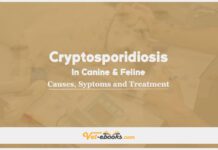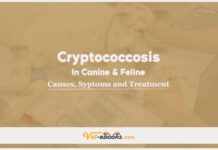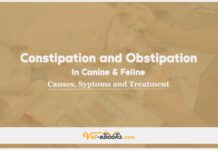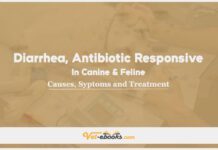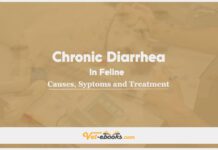Exocrine Pancreatic Insufficiency In Canine and Feline: Causes, Symptoms and Treatment
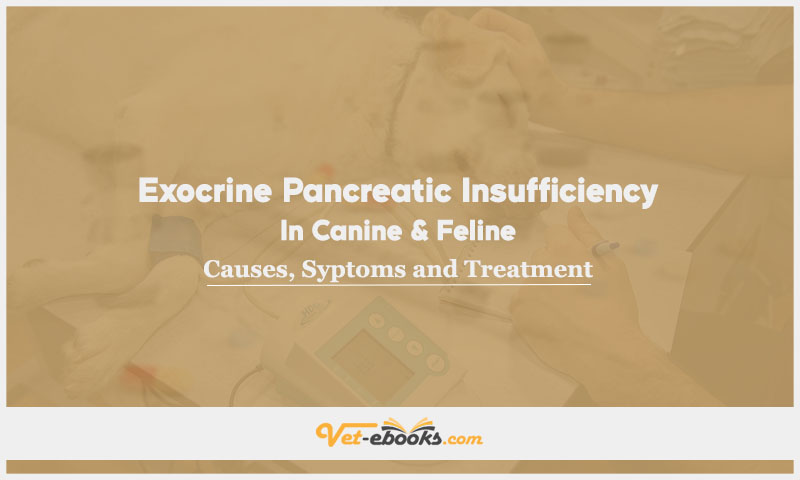
Contents
hide
Overview
Insufficient levels of pancreatic digestive enzymes exist within the lumen of the small intestine.
Causes of Exocrine Pancreatic Insufficiency In Canine and Feline
Causes
- Chronic pancreatitis.
- PAA.
- Pancreatic adenocarcinoma or other abdominal tumors result in obstruction of the pancreatic duct.
Risk factors
- Breed: German shepherd dogs, rough-coated collies, and Eurasians.
- Any condition that makes dogs or cats more susceptible to chronic pancreatitis.
Pathogenesis of Exocrine Pancreatic Insufficiency In Canine and Feline
- The exocrine pancreas does not make enough pancreatic enzymes or secrete them enough, which is what causes this condition.
- In certain cases, the condition arises due to an obstruction in the pancreatic duct or a shortage of isolated lipase.
- The breakdown of acinar cells in the pancreas due to chronic pancreatitis, which affects about half of all dogs and almost all cats, means that digestive enzymes do not mix properly.
- It can be attributed to idiopathic PAA, which is the most prevalent cause of EPI in German shepherd dogs.
- Insufficient exocrine pancreatic secretion is associated with maldigestion and impaired absorption of nutrients, resulting in weight loss and loose stools characterized by steatorrhea.
- Malabsorption contributes to dysbiosis in the small intestine.
Symptoms (History & Physical Examination) of Exocrine Pancreatic Insufficiency In Canine and Feline
History
- Weight reduction with a normal to heightened appetite.
- Persistent loose stools or diarrhea for an extended period of time.
- Fecal volumes increase beyond the typical range and may be linked to steatorrhea.
- Flatulence and borborygmus are observed, particularly in canines.
- Coprophagia and/or pica.
- Polyuria and polydipsia are consequences of chronic pancreatitis, leading to the development of diabetes mellitus.
Physical Examination
- Low physical condition (reduced muscular mass and suboptimal hair coat quality).
- Cats exhibiting steatorrhea may have a greasy deposition of the hair coat in the perineal region (minority of instances).
Diagnosis of Exocrine Pancreatic Insufficiency In Canine and Feline
1- From History and Physical Examination
2- Diagnostic Procedures
CBC/BIOCHEMISTRY/URINALYSIS
Does not show any abnormalities.
OTHER LABORATORY TESTS
Trypsin-Like Immunoreactivity (TLI):
- The preferred diagnostic test for both canines and felines.
- Test Principle: To measure serum TLI, trypsinogen and trypsin that are released directly into the bloodstream from pancreatic acinar cells must be found.
- Serum TLI is present in the serum of all healthy dogs and cats with properly functioning exocrine pancreatic tissue.
- When animals have EPI, the levels of serum TLI drop by a large amount.
- The level of canine trypsin-like immunoreactivity (cTLI) in dogs is thought to be less than or equal to 2.5 μg/L.
- In feline species, the threshold limit for feline thyroid hormone concentration is equal to or less than 8.0 μg/L.
- The TLI tests for canines and felines are designed to specifically target the respective species.
- In the case of any canine or feline exhibiting symptoms such as weight loss, loose feces, or any other clinical manifestations mentioned, it is important to take note.
- The advantages of this diagnostic test include its simplicity, speed, requirement for only one serum specimen obtained after fasting, and high sensitivity and specificity for detecting EPI in both species.
Other Exocrine Pancreatic Function Tests:
- Fecal proteolytic activity assays utilizing casein-based substrates are employed to diagnose EPI in both canines and felines.
- The presence of fecal proteolytic activity has been linked to the occurrence of both false-positive and false-negative test outcomes.
- It is advisable to only depend on this method in cases involving exotic species when a serum TLI test is not accessible.
- A method for quantifying fecal elastase levels has been described for application in canines.
- This test is correlated with a substantial incidence of false-positive test outcomes and hence cannot be approved at present.
- In order to confirm the presence of EPI, a positive test outcome necessitates the measurement of a blood concentration of cTLI.
Cobalamin and Folate:
- Conducted in conjunction with TLI, panel discussions are a common format.
- Evaluate the presence of contemporaneous dysbiosis or concurrent small intestine disease, such as IBD.
- Cobalamin (vitamin B12) is insufficient in dogs and cats with EPI.
- Failure to address this deficiency results in treatment failure or the development of problems.
3- Differential Diagnosis
- Secondary etiologies of persistent diarrhea and weight loss include hepatic failure, renal failure, hypoadrenocorticism, and hyperthyroidism in cats.
- Primary gastrointestinal disease (infectious, inflammatory, neoplastic, mechanical, or toxic).
Treatment of Exocrine Pancreatic Insufficiency In Canine and Feline
General:
- The primary goal of treatment is to achieve a state of clinical health in the patient by means of supplementing digestive enzymes.
- The majority of animals do not experience a restoration of exocrine pancreatic function.
- Even with the administration of digestive enzyme supplements, normalization of digestive function does not occur.
- It may be necessary for the treatment to address particular nutritional deficiencies, particularly cobalamin deficiency, secondary small intestine dysbiosis, and/or the lack of response to enzyme supplementation as the sole intervention.
Medications:
Pancreatic enzyme supplements in powdered form
- The preferred treatment option.
- An initial dosage of 1 teaspoon per 10 kilograms of body weight during each meal, ensuring a minimum of two meals each day to facilitate weight gain.
- The preincubation of enzymes with food does not have a substantial impact on the effectiveness of oral enzyme therapy.
- The enzyme product should possess a minimum of 70000 USP lipase per teaspoon of product, which is equivalent to 23000 IU lipase.
- Cheaper alternatives frequently do not meet these thresholds.
- If a patient declines to ingest the enzyme supplement, contemplate the utilization of raw, diced pancreas derived from any species.
- Microencapsulated items may also be employed, however, it is advisable to refrain from utilizing tablets and capsules that contain enzyme powder.
- Most canines and felines exhibit a positive response to therapeutic interventions within 5 to 7 days.
- Once a comprehensive response is attained, progressively decrease the quantity of pancreatic enzyme supplements to a level that effectively avoids the reappearance of clinical indications.
Cobalamin supplementation
- In cases of cobalamin deficiency.
- Pure injectable cyanocobalamin for cats (250μg each injection), while for dogs (from 250μg to 1500μg per injection).
- Once a week for six weeks, followed by an additional dose one month later.
- A recheck of the serum cobalamin concentration should be conducted one month after the previous dose.
- Pure cyanocobalamin for oral administration (250μg per dose in cats and 250–1500μg per dose in dogs) once daily for 120 days.
- Following the completion of the treatment period, a recheck of the serum cobalamin concentration should be conducted two weeks after the final dose.
proton pump inhibitor
- Omeprazole (0.7-1.0mg/kg orally every 12 hours).
Oral antibiotic therapy
- In patients with concurrent small intestine dysbiosis, administer tylosin (25mg/kg PO q12h, for 4-6 weeks).
- In most patients, dysbiosis tends to cure spontaneously following initiating enzyme replacement therapy.
Some Notes:
- Oral bleeding is reported in patients who are administered digestive enzyme powder.
- It is important to initially rule out a rare coagulopathy that arises from a lack in vitamin K.
- In the majority of these patients, a reduction in dosage leads to cessation of oral bleeding.
- The addition of water to the pet food/enzyme mixture may potentially facilitate the desired outcome.
Tip
Do You Want To Increase Your Veterinary Knowledge and Practical Skills?
You Can Now Browse and Download +3000 Books For Veterinary Professionals & Students Online.
Download Veterinary Books

